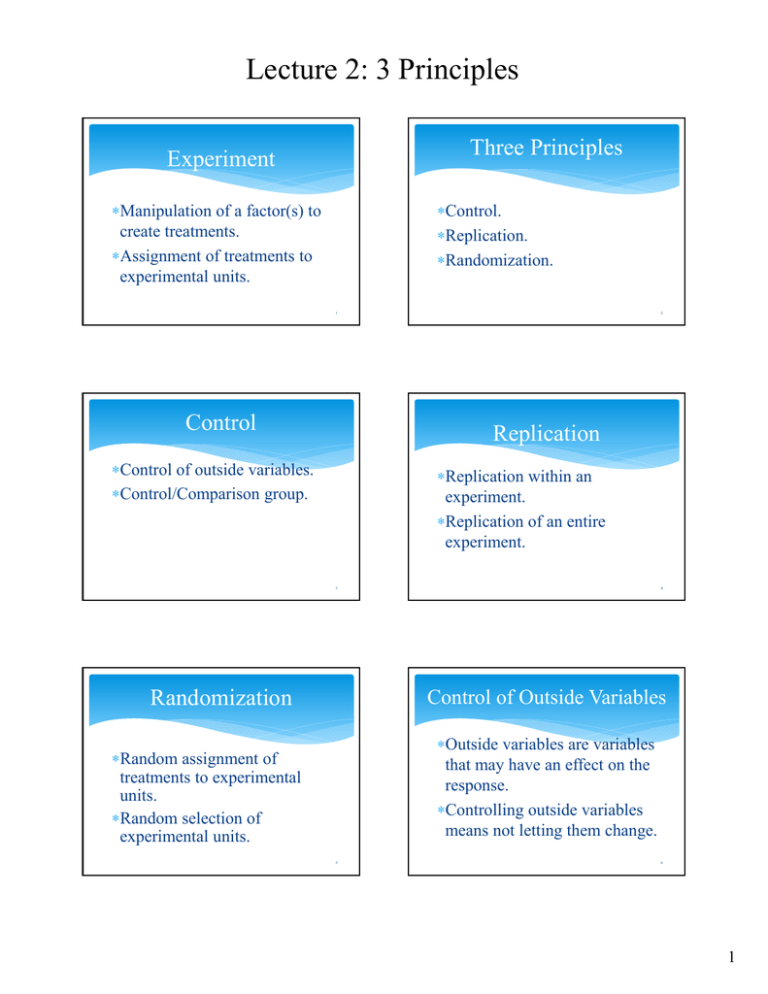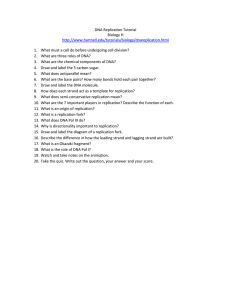Lecture 2: 3 Principles Three Principles Experiment
advertisement

Lecture 2: 3 Principles Three Principles Experiment Manipulation of a factor(s) to create treatments. Assignment of treatments to experimental units. Control. Replication. Randomization. 1 Control 2 Replication Control of outside variables. Control/Comparison group. Replication within an experiment. Replication of an entire experiment. 3 Randomization 4 Control of Outside Variables Outside variables are variables that may have an effect on the response. Controlling outside variables means not letting them change. Random assignment of treatments to experimental units. Random selection of experimental units. 5 6 1 Lecture 2: 3 Principles Example Control of Outside Variables Outside variables that may affect blood pressure. Same age – 50 years. Same gender – women. Same exercise – 30 minutes a day three days a week. Hard to control stress and heredity. Age Gender Exercise Stress Heredity 7 Purpose of Control 8 Problem with Control The purpose of control of outside variables is to isolate the effect of the treatments, i.e. the manipulated variable. By controlling outside variables it is hard to make broad generalizations. Can only generalize to experimental units like the ones used in the experiment. 9 10 Control/Comparison Group Control/Comparison Group A group of experimental units used to see if the factor of interest has any effect at all. Placebo Group Standard Treatment Group 11 12 2 Lecture 2: 3 Principles Placebo Group Placebo Group A placebo is not an active treatment, e.g. a treatment with no active “ingredient”. In the sodium and blood pressure experiment the placebo would be a diet with no sodium. If other treatments are different from the placebo, we know that the factor of interest has an effect at some level. 13 14 Comparison Group Standard Treatment Group In an experiment looking at the effect of drill speed (rpm) on the surface roughness of drilled holes the standard treatment would be the drill speed that is currently being used. Can then evaluate how changing the speed affects the surface roughness and make a recommendation to improve the process. 15 Replication 16 Purpose of Replication Experimental units receiving the same treatment are treated the same. Replication allows us to quantify the natural variation in units treated the same. Replication within an experiment requires assignment of each treatment to several (more than one) experimental units. 17 18 3 Lecture 2: 3 Principles Purpose of Replication Purpose of Replication The quantification of natural variation in units treated the same provides a means for determining if differences between treatments are statistically significant. Can the difference between observed treatment means be explained by natural variation or could it be due to the treatment? 19 Replication 20 Replication Replication of the entire experiment means doing the experiment again with different experimental units. Without replication within an experiment it is difficult to determine statistically significant differences. 21 22 Replication Replication Replication of an entire experiment allows us to see if the effect of treatment can be repeated (replicated). Replication of the entire experiment with different experimental units (e.g. men instead of women) allows us to see if the effect of treatment is the same for both genders. 23 24 4







